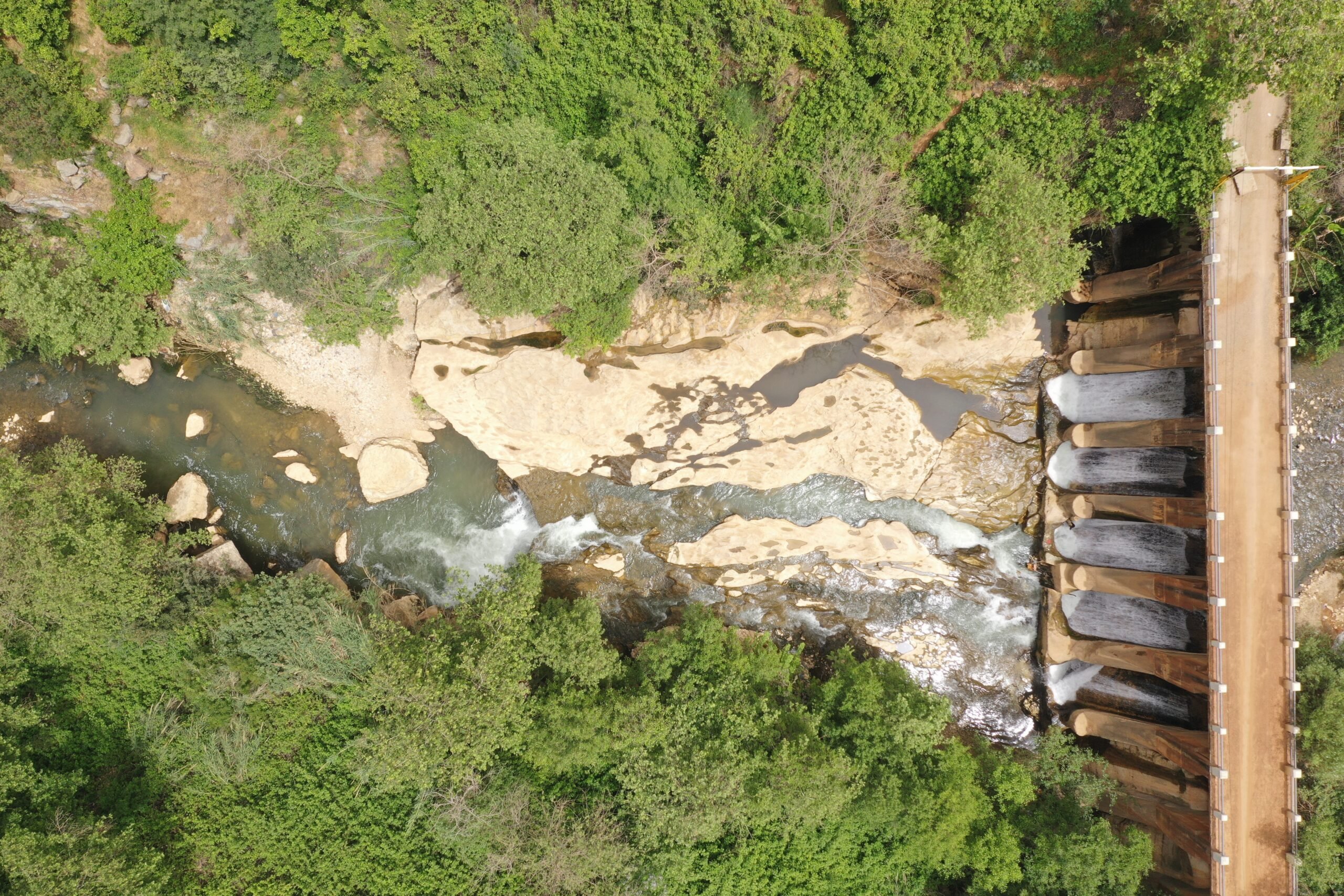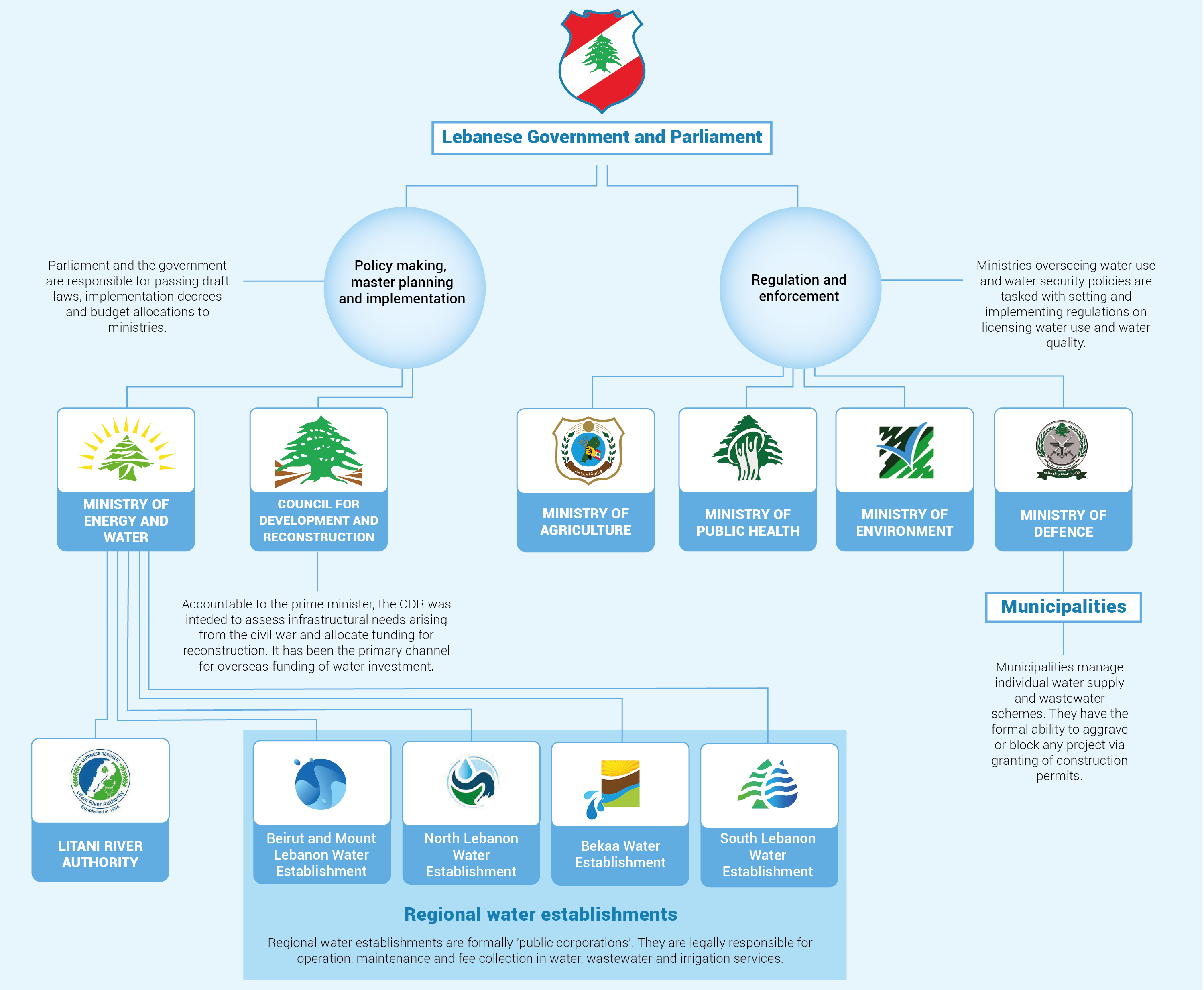
Key governmental and non-governmental organizations
The main governmental institutions involved in water management are the Ministry of Energy and Water (MoEW), the Council for Development and Reconstruction (CDR), the four regional water establishments (NLWE in North Lebanon, SLWE in South Lebanon, BWE in Bekaa, BMLWE in Beirut Mount Lebanon) and the Litani River Authority (LRA). When it comes to water management, water use and demand are influenced by other institutions that are the main water users or have an impact on regulations, processes or tariffs. These include the Ministry of Agriculture (MoA), Ministry of Economy and Trade (MoET), Ministry of Public Health (MoPH), Ministry of Finance (MoF) and Ministry of Environment (MoE). Finally, local municipalities play a local role in domestic water management. The involvement of so many governmental institutions, and the lack of clear laws and regulations stating the role of each, have resulted in fragmentation and overlap between these institutions. Figure 1 shows the key actors in the water sector and the main responsibilities they have.
Laws and regulations that are in use or in preparation
For a long time, Lebanon’s water sector has been negatively affected by the lack of implementation of relevant laws and public policies.1 The current legal and regulatory framework revolves around four main legal documents: the Ottoman decision number 320/1920; decision number 144/5/1920; Law 221/2000 and its amendments; and the Water Code 77/2018 and its amendment, which are currently under review. The Water Code was ratified without considering the revisions made by the sub-parliamentary committee in May 2020. It is important that the new version of the code is ratified in order to draft the executive decrees necessary for the application of the law.[2]
Law 221/2000 is important because it identified and specified the rights and responsibilities of the MoEW and water establishments (WEs). Before this law, 21 water authorities existed but were financially and technically frail. Under this law, they were grouped into four regional WEs. They are considered to be more or less autonomous administrations with a mandate to manage the water resources in the respective regions. However, they have inherited the previous financial and technical weaknesses.
It is worth mentioning that the LRA also has a mandate related to the management of the water sector. Originally, LRA’s main tasks included implementing the Litani irrigation, drinking water and electricity projects, establishing a network to link power stations in Lebanon, establishing electrical substations and distribution lines in all regions, and investing in the different parts of the projects at both the technical and administrative levels.
Several other functions have been added since the LRA’s establishment. These include: water monitoring of all rivers in Lebanon; managing irrigation projects in central and northern Bekaa; conducting studies related to diverting water on tributaries of the Jordan River Basin, mountain lakes in the northern and Mount Lebanon areas; and conducting studies on the construction of the Bisri Dam on the Awali River.[3] However, the LRA currently manages specific projects, including implementation of the South Bekaa and Qasimiya-Ras El Ain irrigation projects and the Saida-Jezzine irrigation project (pilot area); hydropower projects which are dependent on the Litani River; and the monitoring of all rivers in Lebanon.
Two water establishments fall within the hydrological boundaries of the Litani River Basin: South Lebanon and Bekaa. This has led to an overlap of tasks between these different authorities, mainly related to exploitation of resources, project management, tariff systems (irrigation projects) and monitoring.

Financing of the water sector
Financing of the water sector in Lebanon depends largely on foreign funding, mainly because of the absence of adequate local finances, a water policy and strong administration. It is estimated that since 1992, around $3 billion in foreign funds have been directed to the water sector. During the CEDRE donor conference in 2018, Lebanon received pledges of $11.5 billion. Of this, around a third was to be dedicated to the water sector and water-related projects. In 2019, several loans were authorized, with some linked to water projects. However, the government failed to take the necessary reformative steps required by the international community to unlock the CEDRE money.[4]
The main funders are The World Bank, the European Investment Bank, France (Agence Française de Développement), Germany (Deutsche Gesellschaft für Internationale Zusammenarbeit – GIZ and Kreditanstalt für Wiederaufbau – KfW), Italy, Japan, the United States (USAID), the Arab Fund for Economic and Social Development, the Kuwait Fund for Arab Economic Development and the Saudi Fund for Development.1 [4]
The funding for the planned projects in the NWSS 2020 is also assumed to be from international sources, with limited projects funded locally.[2]
Role of the private sector in water management
Involvement of the private sector in the water sector has been slow. However, the private sector has stepped in to fill critical gaps left by state institutions, with multinational private companies benefiting significantly from this dysfunctional sector. For example, the water bottling sector alone is worth $160 million.1
Recently, Law 77/2018 has permitted the private sector to participate in several activities. Its involvement may help improve certain functions at the regional water stablishments, specifically related to customer relations, customer database management, communication, billing and water meter reading.1
a href=”#_ftnref1″ name=”_ftn1″>[1] MoE (Ministry of Environment), 2020. Lebanon State of the Environment and Future Outlook: Turning the Crises into Opportunities (SoER 2020). With UNHCR, UNICEF and UNDP.
[2] MoEW (Ministry of Energy and Water), 2020. National Water Sector Strategy Update 2020.
[3] LRA (Litani River Authority, n.d. LRA official website.
[4] Gharios, G and Farajalla, N, 2019. Connecting Various Investment Plans to Address New Challenges in the Current Water Management Structure of Lebanon. Conference Paper: Second Lebanon Water Forum in Beirut, Lebanon.

